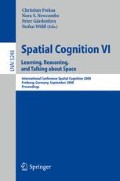Abstract
According to Clark [1] language is a joint activity between speaker and listener, undertaken to accomplish a shared goal. In the case of spatial descriptions, one such goal is for a speaker to assist a listener in finding a sought-for object. For example, imagine misplacing your keys on a cluttered desktop, and asking your friend if s/he knows where they are. In response, there are a variety of spatial descriptions that your friend can select that vary in complexity, ranging from a simple deictic expression such as “there” (and typically accompanied by a pointing gesture), to a much more complicated description such as “its on the desk, under the shelf, to the left of the book and in front of the phone.” Between these two extremes are descriptions of the form “The keys are by the book”, consisting of three parts: the located object that is being sought (i.e., the keys); the reference object from which the location of the located object is specified (i.e., the book) and the spatial term that conveys the spatial relation between these two objects (i.e., by). For inquiries of this type (“where are my keys?”), the located object is pre-specified, but the speaker needs to select an appropriate spatial term and an appropriate reference object. My research focuses on the representations and processes by which a speaker selects these spatial terms and reference objects, and the representations and processes by which a listener comprehends these ensuing descriptions.
Access this chapter
Tax calculation will be finalised at checkout
Purchases are for personal use only
References
Clark, H.H.: Using language. Cambridge University Press, Cambridge (1996)
de Vega, M., Rodrigo, M.J., Ato, M., Dehn, D.M., Barquero, B.: How nouns and prepositions fit together: An exploration of the semantics of locative sentences. Discourse Processes 34, 117–143 (2002)
Miller, G.A., Johnson-Laird, P.N.: Language and perception. Harvard University Press, Cambridge (1976)
Talmy, L.: How language structures space. In: Pick, H.L., Acredolo, L.P. (eds.) Spatial orientation: Theory, research, and application, pp. 225–282. Plenum, New York (1983)
Craton, L.G., Elicker, J., Plumert, J.M., Pick Jr., H.L.: Children’s use of frames of reference in communication of spatial location. Child Developmen 61, 1528–1543 (1990)
Clark, H.H.: Space, time, semantics, and the child. In: Moore, T.E. (ed.) Cognitive development and the acquisition of language. Academic Press, New York (1973)
Fillmore, C.J.: Santa Cruz lectures on deixis. Indiana University Linguistics Club, Bloomington (1971)
Hund, A.M., Plumert, J.M.: What counts as by? Young children’s use of relative distance to judge nearbyness. Developmental Psychology 43, 121–133 (2007)
Blocher, A., Stopp, E.: Time-dependent generation of minimal sets of spatial descriptions. In: Olivier, P., Gapp, K.P. (eds.) Representation and processing of spatial relations, pp. 57–72. Erlbaum, Mahwah (1998)
Carlson-Radvansky, L.A., Tang, Z.: Functional influences on orienting a reference frame. Memory & Cognition 28, 812–820 (2000)
Carlson, L.A., Hill, P.L.: Processing the presence, placeent and properties of a distractor in spatial language tasks. Memory & Cognition 36, 240–255 (2008)
Olson, D.: Language and thought: Aspects of a cognitive theory of semantics. Psychological Review 77, 143–184 (1970)
Carlson, L.A., Logan, G.D.: Using spatial terms to select an object. Memory & Cognition 29, 883–892 (2001)
Author information
Authors and Affiliations
Editor information
Rights and permissions
Copyright information
© 2008 Springer-Verlag Berlin Heidelberg
About this paper
Cite this paper
Carlson, L.A. (2008). On the “Whats” and “Hows” of “Where”: The Role of Salience in Spatial Descriptions. In: Freksa, C., Newcombe, N.S., Gärdenfors, P., Wölfl, S. (eds) Spatial Cognition VI. Learning, Reasoning, and Talking about Space. Spatial Cognition 2008. Lecture Notes in Computer Science(), vol 5248. Springer, Berlin, Heidelberg. https://doi.org/10.1007/978-3-540-87601-4_2
Download citation
DOI: https://doi.org/10.1007/978-3-540-87601-4_2
Publisher Name: Springer, Berlin, Heidelberg
Print ISBN: 978-3-540-87600-7
Online ISBN: 978-3-540-87601-4
eBook Packages: Computer ScienceComputer Science (R0)

